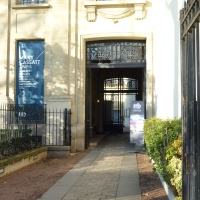Père Lachaise Cemetery, spring 2010. I took this photograph, wondering what on earth a “caveau depositoire” might be. Turns out it is a temporary storage spot for bodies awaiting burial. But what attracted my attention at first was the image of a ship on what at first appears to be a headstone, but is in fact, simply an identification marker on a civic property.
The ship is, of course, the symbol of Paris, and you see it everywhere – on municipal buildings and facilities, including this one in the cemetery. I have photographed many others, from this unusual street sign on the rue de Penthièvre …
…to the tiny one on this marker indicating the boundary stone between Passy and Auteuil on the rue Berton.
But it was only when I put together a little collection of these photos that I noticed something odd. Consider, for example, this elaborate version, on the dome of the Petit Palais.
It has oars. Three oars and three sails. The cemetery version had three sails, but no oars, and many of the others have one sail and no oars. Clearly there is no consistent corporate identity here.
French Wikipedia notes that the coat of arms may have one, two or three masts and might or might not have oars. It also shows the standard version and two interesting alternatives.
The current one, shown above, is based on the original 14th century form – a rather unseaworthy-looking craft resembling no known boat shape (a semicircular profile with a single sail on top), perched on some choppy-looking waves.
The second, from the First Empire, includes bees, symbol of the Emperor Napoleon, and a star, symbol of the army, with a more stable version of the ship. It has an Egyptian figurehead at the front (Isis) and an inverted cross at the back. The former alludes to Napoleon’s military victories in Egypt, I suppose. The latter gave me pause. It was originally the symbol for St. Peter (although it is now associated with black magic). The allusion to St. Peter might have something to do with Napoleon’s takeover of the Papal States.
There is a third version, from the Second Republic (1848-1853), with a bigger, three-masted ship, and stars replacing the fleur-de-lys, which were associated with the recently overthrown royal family.
But not one of these ships has oars. And oars are clearly important, because they are what the city uses to indicate historic locations.
Oars are also prominent in the symbol the city used for the 1924 Olympics.
The inconsistency interested me. So I did a little research on the coat of arms.
The choice of a ship to symbolize Paris was the decision of Charles V in 1358. I’ve seen a couple of theories about why that particular symbol was chosen.
One is that the ship represents the boat-shaped Ile de la Cité, which once constituted the entire town. The oars are the bridges connecting it to the banks on either side. It’s an attractive theory, but probably not historically accurate.
More likely is that the ship represents the powerful guild of the Marchands de l’eau, who dominated the city from its earliest days. Although they sound like water-sellers, in fact this was a guild of boatmen who dominated waterborne trade on the river. What kind of boats would they have had? How big were they? Did they use sails or oars or both?
Both the Romans and the Vikings had ships that combined sails and oars, but they were sea-going ships, rather than rivercraft. And by the medieval period, when the Paris coat of arms came into use, boats had one or the other but usually not both – at least, if the images on the Bayeux tapestry are typical.
So the ship with sails and oars probably evokes the early history of the city the Romans called Lutetia.
In the end, the choice of what to portray seems to be left up to the individual artists and artisans who have created the endless variations of the coat of arms seen around the city. How dull if they were all the same.
And then there are the artistic opportunities in the additional elements of the coat of arms. This one, from the building overlooking the Montsouris reservoir, shows some of these. On top is a combination crown/castle or couronne murale (this one has four towers; some have five), symbolizing the autonomy of the city. There is also an oak branch on the left (a symbol of strength), and a laurel on the right (glory). And you can just see the banner with the motto “Fluctuat nec mergitur”: tossed by the waves, but not sinking.
Of course, exactly 102 years ago today, people were probably wondering about that last bit, as Paris struggled through the great flood of January 1910. Once again, the city depended on boatmen, and pressed rowboats and punts into service to ferry people through the streets. And the city, in the end, did not sink.
Text and original photographs by Philippa Campsie


































And thank God that it did not. Otherwise the rest of us would have had to brush up our aquatic skills and expect a Venice in January scenario but further north and west. I like the theme and the pics in this one. Well done, yet again!
Goodness me… I only ever saw the very stylized version on the descriptions of historical places – and then I thought it was a bird!! Thanks for this enlightenment…
Every day is full of wonders! Thank You 🙂
What an interesting theme. Thank you so much for your work on the subject.
great history about sailing ships, love to see how they played a big role in the history of Paris